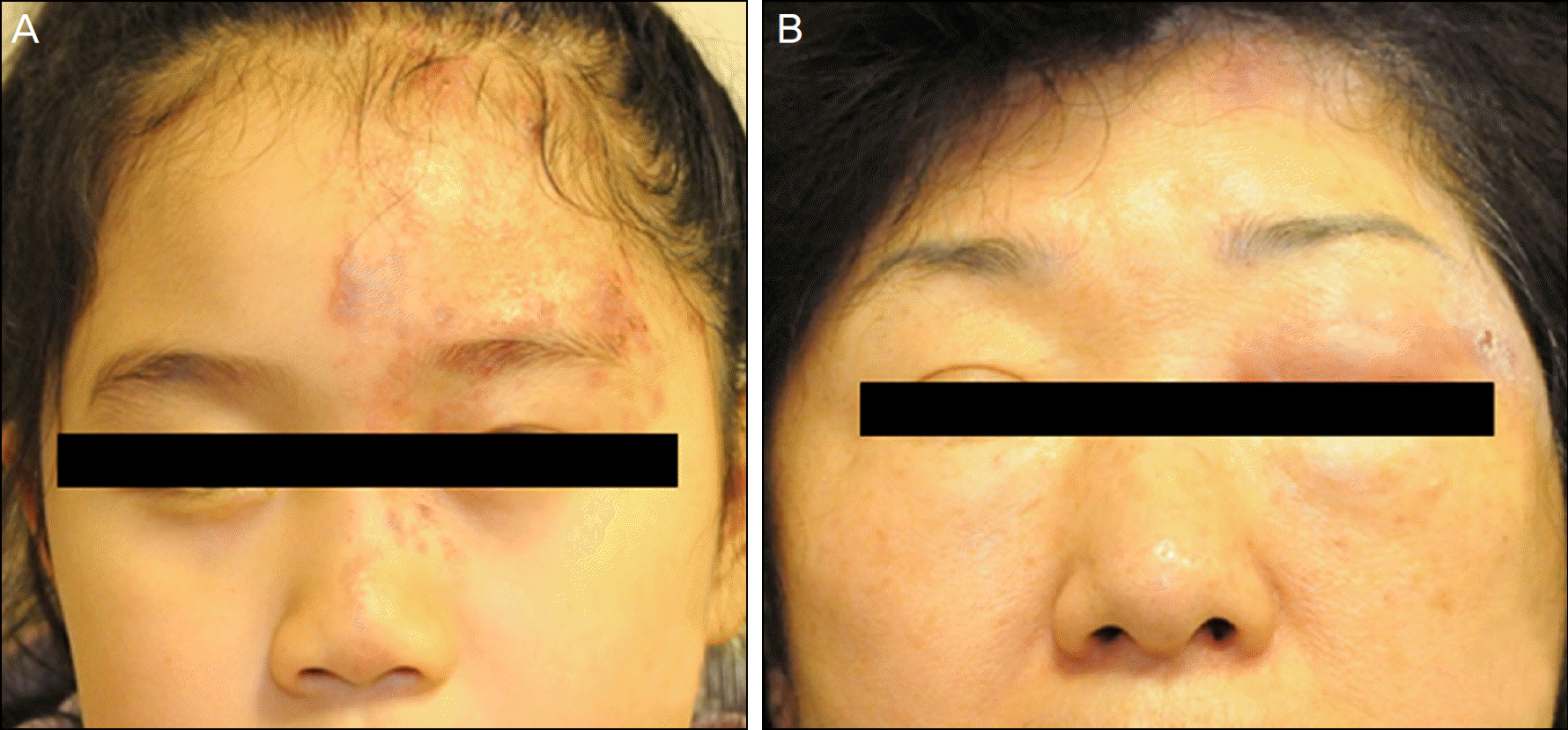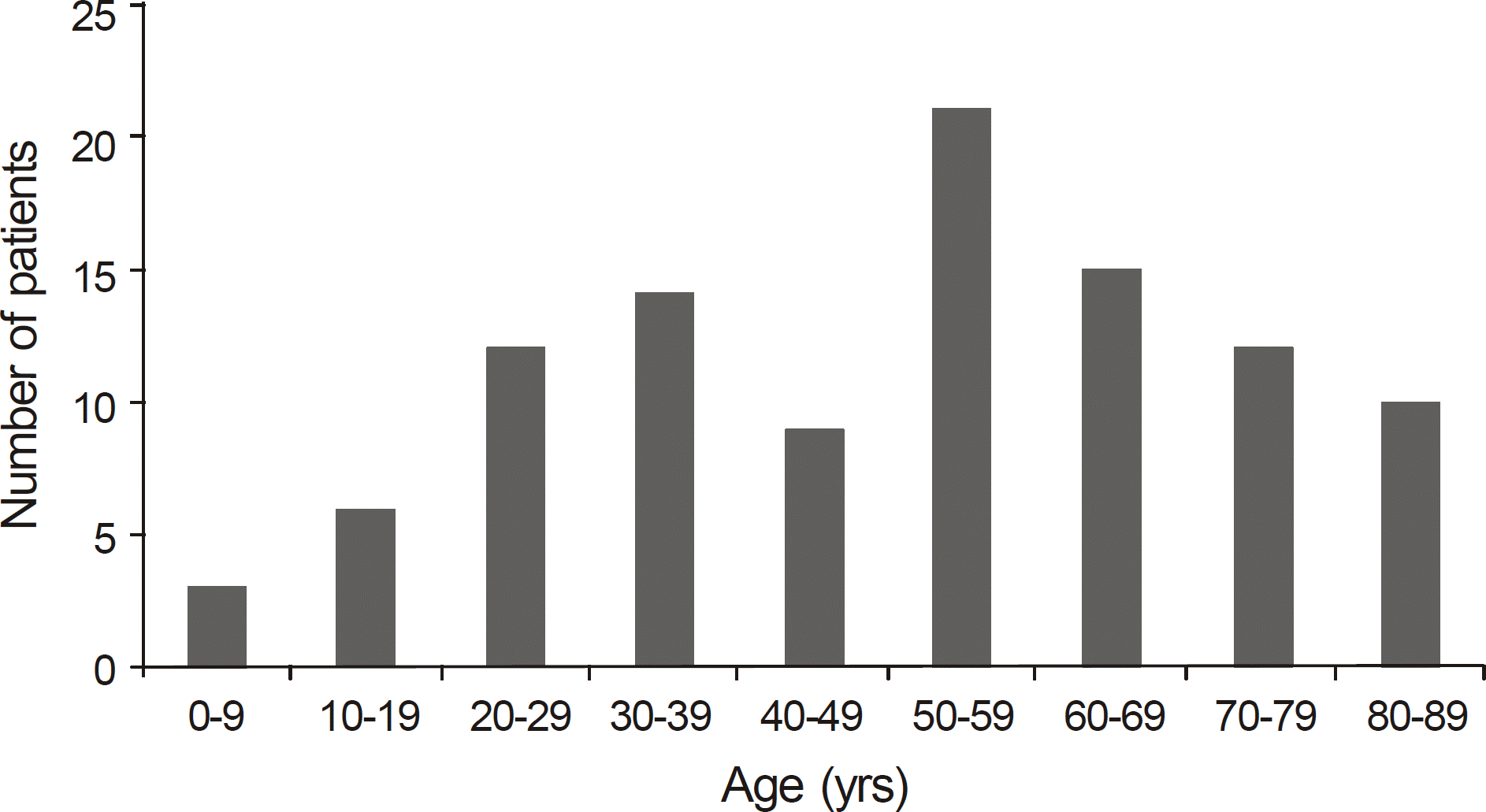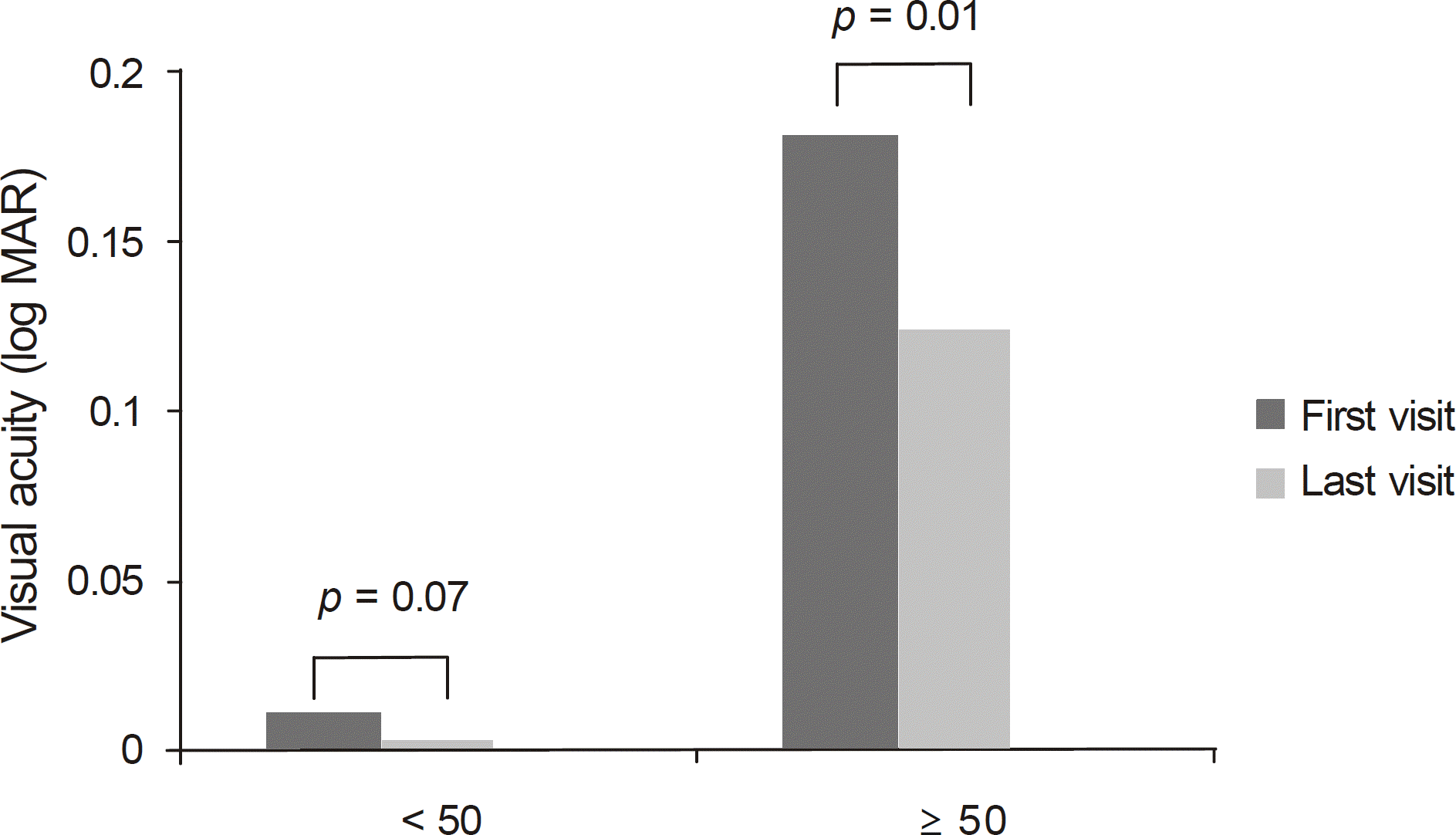Abstract
Purpose
To study the clinical course of herpes zoster ophthalmicus (HZO) and to compare the demographics, treatments, and outcomes in patients under 50 years of age versus patients 50 years of age or older at the time of diagnosis.
Methods
A retrospective chart review was performed of 102 patients who were diagnosed with HZO between January 1, 2008 and December 31, 2010. Baseline demographics and clinical characteristics between patients with an onset of HZO under the age of 50 years and patients with an onset of HZO at the age of 50 years or older were compared.
Results
Similar numbers of patients were affected with HZO in the younger and older age groups (n = 44, 43.1%, vs. n = 58, 56.9%). The mean ± SD of age was 50.6 ± 21.8 years (range, 3–89 years) and the most common decade of HZO onset was between 50 and 59 years. Gender and disease laterality were not statistically different between the 2 groups. No significant difference was found regarding the presence of any ocular manifestation between the groups; however, anterior uveitis was more frequent in the younger patients (p = 0.04). The number of patients with immunosuppressive therapy was higher in the younger age group (p = 0.01).
Conclusions
HZO-affected patients under the age of 50 years and older than 50 years were equally distributed, with the most common decade of onset between the age of 50 and 59 years. Younger patients had a higher incidence of anterior uveitis and immunosuppressive therapy due to underlying systemic diseases.
Go to : 
References
1. Ragozzino MW, Melton LJ 3rd, Kurland LT, et al. Population-based study of herpes zoster and its sequelae. Medicine (Baltimore). 1982; 61:310–6.

2. De Moragas JM, Kierland RR. The outcome of patients with herpes zoster. AMA Arch Derm. 1957; 75:193–6.

3. Katz J, Cooper EM, Walther RR, et al. Acute pain in herpes zoster and its impact on health-related quality of life. Clin Infect Dis. 2004; 39:342–8.

4. Hope-Simpson RE. The nature of herpes zoster: a long-term study and a new hypothesis. Proc R Soc Med. 1965; 58:9–20.

5. Zhou F, Harpaz R, Jumaan AO, et al. Impact of varicella abdominal on health care utilization. JAMA. 2005; 294:797–802.
7. Oxman MN, Levin MJ; Shingles Prevention Study Group. Vaccination against Herpes Zoster and Postherpetic Neuralgia. J Infect Dis. 2008; 197(Suppl 2):S228–36.
8. Ghaznawi N, Virdi A, Dayan A, et al. Herpes zoster ophthalmicus: comparison of disease in patients 60 years and older versus abdominal than 60 years. Ophthalmology. 2011; 118:2242–50.
10. Donahue JG, Choo PW, Manson JE, Platt R. The incidence of abdominal zoster. Arch Intern Med. 1995; 155:1605–9.
11. Gilden DH, Cohrs RJ, Mahalingam R. VZV vasculopathy and postherpetic neuralgia: progress and perspective on antiviral therapy. Neurology. 2005; 64:21–5.

12. Cobo M, Foulks GN, Liesegang T, et al. Observations on the natural history of herpes zoster ophthalmicus. Curr Eye Res. 1987; 6:195–9.

13. Lee HJ, Kim SY, Jung MS. The clinical characteristics of facial herpes zoster in Korean patients. J Korean Ophthalmol Soc. 2010; 51:8–13.

15. Goldman GS. Cost-benefit analysis of universal varicella abdominal in the U.S. taking into account the closely related abdominal-zoster epidemiology. Vaccine. 2005; 23:3349–55.
16. Han CS, Miller W, Haake R, Weisdorf D. Varicella zoster infection after bone marrow transplantation: incidence, risk factors and complications. Bone Marrow Transplant. 1994; 13:277–83.
18. Nikkels AF, Nikkels-Tassoudji N, Piérard GE. Revisiting abdominal herpes zoster. Pediatr Dermatol. 2004; 21:18–23.
19. Baba K, Yabuuchi H, Takahashi M, Ogra PL. Increased incidence of herpes zoster in normal children infected with varicella zoster virus during infancy: community-based follow-up study. J Pediatr. 1986; 108:372–7.

20. Feder HM Jr, Hoss DM. Herpes zoster in otherwise healthy children. Pediatr Infect Dis J. 2004; 23:451–7. quiz 458–60.

21. Chung YR, Chang YH, Kim DH, Yang HS. Ocular manifestations of herpes zoster ophthalmicus. J Korean Ophthalmol Soc. 2010; 51:164–8.

22. Fong Choong Y, Austin MW. Secondary glaucoma associated with anterior uveitis, iris pigment epithelitis and herpetic eye infection. Acta Ophthalmol Scand. 2002; 80:672–4.

23. Womack LW, Liesegang TJ. Complications of herpes zoster ophthalmicus. Arch Ophthalmol. 1983; 101:42–5.

24. Liesegang TJ. Corneal complications from herpes zoster ophthalmicus. Ophthalmology. 1985; 92:316–24.

26. Miserocchi E, Waheed NK, Dios E, et al. Visual outcome in herpes simplex virus and varicella zoster virus uveitis: a clinical evaluation and comparison. Ophthalmology. 2002; 109:1532–7.
Go to : 
 | Figure 1.Vesicular lesions over the V1 (ophthalmic nerve) distribution, consistent with the diagnosis of herpes zoster ophthalmicus. (A) 7-year-old female patient with herpes zoster ophthalmicus involving the left nasociliary dermatome. Note the lesions at the side of the tip of the nose (Hutchinson sign). (B) 55-year-old female patient with herpes zoster opthalmicus limited to the frontal nerve dermatome. |
 | Figure 2.Distribution of the age at the time of diagnosis of herpes zoster ophthalmicus by decade. |
Table 1.
Demographic features and baseline characteristics
| Parameters | <50 years | ≥50 years | p-value |
|---|---|---|---|
| Number of patient% (n) | 43.1 (44) | 56.9 (58) | N/A |
| Age at diagnosis (yrs), mean ± SD | 29.6 ± 12.5 | 66.5 ± 11.4 | <0.001* |
| Gender, female% (n) | 36.4 (16) | 48.3 (28) | 0.23† |
| Eye involved, OD% (n) | 54.5 (24) | 56.9 (33) | 0.81† |
| Interval between first symptom and first visit (Days) | 4.02 ± 2.1 | 4.8 ± 2.3 | 0.74† |
| Immunosuppressive therapy % (n) | 11.4 (5) | 0 (0) | 0.01† |
| Cancer % (n) | 2.3 (1) | 5.2 (3) | 0.45† |
| HIV % (n) | 2.3 (1) | 0 (0) | 0.24† |
| Diabetes mellitus % (n) | 0 (0) | 15.5 (9) | 0.01† |
| Hypertension % (n) | 2.3 (1) | 60.3 (35) | <0.001† |
| Hepatitis B % (n) | 0 (0) | 5.2 (3) | 0.14† |
| No medical history % (n) | 75.0 (33) | 36.2 (21) | <0.001† |
Table 2.
Treatment profile of acute herpes zoster ophthalmicus
| Treatment | <50 years | ≥50 years | p-value* |
|---|---|---|---|
| Inpatients % (n) | 53.5 (21) | 45.0 (24) | 0.52 |
| Systemic antiviral therapy % (n) | 100.0 (44) | 100.0 (58) | N/A |
| Systemic antiviral within 72 hrs % (n) | 50.0 (22) | 36.2 (21) | 0.16 |
| Topical antiviral % (n) | 86.4 (38) | 86.2 (50) | 0.98 |
| Topical steroid % (n) | 43.2 (19) | 43.1 (25) | 0.39 |
| Duration of follow‐ up (day), mean ± SD SD | 24.6 ± 64.1 | 57.9 ± 138.1 | 0.15 |
Table 3.
Ocular manifestation of herpes zoster ophthalmicus in 2 groups divided by age 50
| Ocular manifestation | <50 years | ≥50 years | p-value* |
|---|---|---|---|
| Eyelid eruption | 86.4% (38) | 81.0% (47) | 0.32 |
| Conjunctivitis | 68.2% (30) | 60.3% (35) | 0.52 |
| Keratitis | 50.0% (22) | 50.0% (29) | 1.0 |
| Anterior uveitis | 25.0% (11) | 10.3% (6) | 0.04 |
| EOM palsy | 2.3% (1) | 0.0% (0) | 0.24 |
| Scleritis | 6.8% (3) | 1.7% (1) | 0.19 |
| Retinal lesion | 0.0% (0) | 0.0% (0) | N/A |
| Increased IOP | 2.3% (1) | 0.0% (0) | 0.24 |




 PDF
PDF ePub
ePub Citation
Citation Print
Print



 XML Download
XML Download